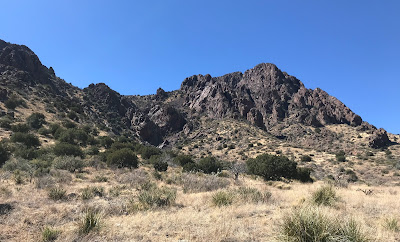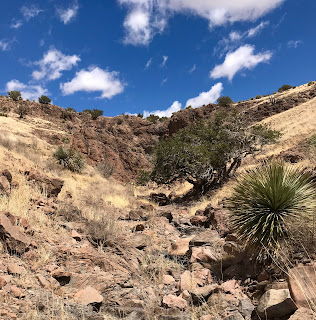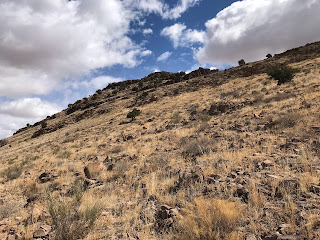Ruins - Sierra County
I discovered, a couple of years ago while trying figure out where several ruins on the Cibola National Forest were, that sometimes they are hiding in plain sight. Many"ruins" sites, but not all, are indicated on USGS topo maps. If they are on USGS topos, then they are also on On-X (which I have) or other similar apps. Still, it was unexpected for me to find one of these "ruins" locations fairly close to home while scanning topos ( using my topo app for MacBook Air) recently. I had had a passing interest for many years in a site called La Capilla de Don Silverio, while looking at a map that covers the region just to the northwest of Hatch, New Mexico. It seemed odd to have a small chapel on the relatively remote, and mostly roadless west side of the river in this area. More recently I got the notion to find the spot on Google Earth. I did, but now it is known as the Santo Niño de Atocha Shrine.
Back to the topo scanning, I found, just over the line in Sierra County, in one of the branches of the Arroyo Cuervo in little letters, with a couple of little boxes, a "ruins" indicated about a mile and a half up the wash from the Shrine or Capilla (chapel). Well, that was exciting. I quickly began looking at Google Earth and yes, there was something to see there, especially when I looked at images going back to 2011. It didn't look like much, but I was still excited.
A bit of problem, I surmised, correctly as it turns out, is that this area receives heavy off- roading use (which is prohibited by the BLM of course). I did not want to visit on a weekend. Problem resolved: on the Friday of my Spring Break, I just decided to go for it and drove out there after lunch. It was only slightly tricky getting there. I took a road that I thought was Arroyo Cuervo Road at an intersection and had brief detour that probably only totaled 10 minutes or so. Back on track, I drove the well maintained actual Arroyo Cuervo Road to more or less its formal end just past the Shrine and parked next to a juniper tree. A couple was standing there looking out to the desert ( I had passed their parked van moments before), and I felt bad for disturbing them on this deadly quiet warm Spring afternoon. I asked if they were going to the chapel. I guess they had already been, but they told me it was open. I marched up the steep sandy road buttressed with old tires, slid the bolt of the door and entered this strange place.
 |
| Santo Niño de Atocha Shrine |
There were candles, statues and other images of Catholic iconography. There were photos too, of families and loved ones. I felt a little profane and resisted any temptation to take photos. Instead, I knelt down at the single kneeler that had a worn bible on its shelf and instantly remembered that it would be one year since my very best friend, David Soules, had died. I mumbled the Lord's Prayer and left quickly. I had talked to David once about this place. He had definitely noticed it too. I don't know if he ever visited here. I don't know if he knew about the ruins on the topo either. But now I felt I had him with me. When a dust devil softly crept up from behind me as I made my way up the wide, sandy wash moments later, it seemed strangely appropriate with the sand brushing against my neck that gave me a chill down to my feet. When I realized what it was, I smiled, and felt a few moments of blissful calm as it danced off into the brush.
 |
| Nutt Mountain sticking up on the horizon |
It was warm. Really too warm for this little trek, but I motored on. It felt as if I was no longer in the southern New Mexico desert, but something transitional. Eventually, my app told me I had reached the spot and I lumbered up out of the arroyo onto the brushy banks. Sure enough within seconds, I was seeing the foundation walls, surrounded now by a mound of disintegrated adobe, I had been straining at for weeks on Google Earth. There appeared to be three bedroom size structures, plus a large area that was devoid of vegetation.
 |
| Stone foundations |
 |
| Stones from the foundation |
I searched the whole area over at least three times, but really saw nothing that I was 100% convinced was an artifact. There may have been some broken pieces of manos and metates, and maybe a bit of lithic debitage, but really there just wasn't anything like what I have found at other habitation sites. This might be expected as the wash is easily driven to and the place may have been picked clean over the many years. It could also have been excavated at some point in the past as well, I don't know.
I began to have a little doubt creep in as to the nature of the age of the ruins. Were they made by ancient Native Americans or from some more recent era? I believe that map makers only use the designation for pre-historic ruins in Southwest, plus there was very little in the way of 19th or 20th century artifacts about to make me feel otherwise.
On my way in I had noticed a muddy spring just downstream of the ruins, which of course explained why the ruins were there in the first place- similar to when we visited the Gallinas Springs Ruins near Magdalena. I looked around the opposite stream bank in the vicinity of the spring with its aged cottonwoods, but there was little else to find in the way of evidence for ancient human habitation. I headed back mostly on the banks, and not in the wash. I saw several deer climb upon the upper benches at my approach.
 |
| Deer |
I trudged through, up and over the dunes of pale red sand until I was back at my truck. I had been in a hurry much of the time, a bit paranoid about encountering a partying crowd that might show up on a Friday afternoon. I'm never far from my neurotic self, but there was ample evidence in the form of tracks, beer cans, bottles, shot gun shells and more, that at least my imaginings were not completed unfounded.
I would like to know more about these places. I would like to visit in less of a rush one day. I drove home uneventfully.
 |
| La Capilla de Don Silverio |
NOTE: Most of this hike is on BLM or State Trust Lands, however the ruins themselves are on small parcel of un-posted private property. Please be respectful if you go.





























































